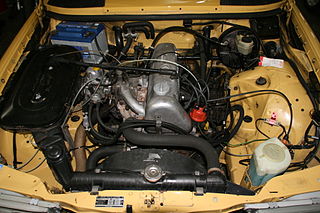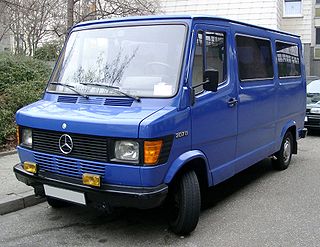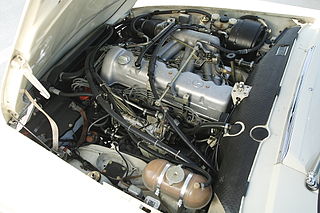
The Mercedes-Benz W201 is the internal designation for the Mercedes 190 series sedans, a range of front-engine, rear drive, five passenger, four-door sedans manufactured over a single generation, from 1982 to 1993 as the company's first compact class automobile.

The Mercedes-Benz M113 engine is a gasoline-fueled, spark-ignition internal-combustion V8 automobile engine family used in the 2000s. It is based on the similar M112 V6 introduced in 1997, then later phased out in 2007 for the M156 AMG engine and the M273 engine.

The Mercedes-Benz W123 is a range of executive cars produced by German manufacturer Mercedes-Benz from November 1975 to January 1986. The W123 models surpassed their predecessor, the Mercedes-Benz W114, as the most successful Mercedes, selling 2.7 million units before production ended in the autumn of 1985 for the saloon/sedan versions and January 1986 for coupés and estates/station wagons.

The M115 engine family was a straight-4 automobile engine from Mercedes-Benz that was produced during the 1970s. This engine was a successor from the M121 and was replaced by the M102 engine. This engine is modified from the M121 by adding a five-bearing crankshaft. The same engine was produced in several versions with differing volume, compression, and horse power according to its application.

The M102 engine family is a inline-four gasoline automobile engine family built by Mercedes-Benz in the 1980s and early 1990s. It is a relatively oversquare engine with a large bore and short stroke compared to the M115 engine which was used during the same timeframe.

The M110 engine family is a DOHC crossflow cylinder head design with 2 valves per cylinder straight-6 automobile engine made by Mercedes-Benz in the 1970s and 1980s.

The M123 engine family was a straight-6 automobile engine from Mercedes-Benz, used from 1976 to 1984 in the W123 series models 250 and 250 T. It replaced the 6-cylinder engines M180 in the 230 and M130 in the 250 versions from the W114 series.

The OM615 was a inline-four diesel engine made by Mercedes-Benz. A successor to the OM621, it was sold in early 1968 in two versions: 1,988 cc (2.0 L) and 2,197 cc (2.2 L) engine.

The OM617 engine family is a straight-5 diesel automobile engine from Mercedes-Benz used in the 1970s and 1980s. It is a direct development from the straight-4 OM616. It was sold in vehicles from 1974 to 1991. The OM617 is considered to be one of the most reliable engines ever produced with engines often reaching over 1,000,000 km (620,000 mi) without being rebuilt and is one of the key reasons for Mercedes' popularity in North America in the 1980s, as it was powerful and reliable compared to other automotive diesels of the time. It is also a very popular choice for the use of alternative fuels, mainly straight or waste vegetable oil and biodiesel, although the use of these fuels may cause engine damage over time if not processed properly before use.

The HR is a family of straight-3 12-valve and straight-4 16-valve automobile engines with continuously variable valve timing, involving development by Nissan and/or Renault, and also Mercedes-Benz in the case of the H5Ht/M282. The designation of H engine is used by Renault, and M28x by Mercedes-Benz, to classify the family. There are three basic specifications of engine involving variations in engine architecture, or all-new architecture, with 72.2 mm (2.84 in), 75.5 mm (2.97 in) and 78 mm (3.07 in) bore diameter.

In 1977 Daimler-Benz introduced a new van/truck, called Mercedes-Benz T1 internally. Other designations were series TN and Bremer Transporter, since the vehicle was built in the Transporter-Plant in Bremen, Germany, first. In the years 1983/1984 production went - piece by piece - to the Transporter-Plant-Düsseldorf. The internal chassis-designations are: 601, 602 and 611.

Force Motors Ltd is an Indian multinational automotive manufacturing company, based in Pune. From 1958 until 2005, the company was known as Bajaj Tempo Motors because it originated as a joint venture between Bajaj Trading Corporation and Germany's Tempo for manufacturing auto components. The company is known for brands, like the Gurkha, Matador, Minidor and Traveller. Over the last five decades [when?], it has partnered with global manufacturers, such as Rolls Royce, BMW, Daimler, ZF, Bosch, VW, Traton and MAN, for manufacturing auto components.

The Mercedes Benz M180 engine was a 2.2 L; 134.0 cu in (2,196 cc) single overhead camshaft inline-6 cylinder engine introduced at the Frankfurt Motor Show in April 1951 to power the company's new 220 (W187). It was the first engine with a cylinder bore greater than its stroke that Mercedes had installed in a production car, while using a reverse-flow cylinder head.

Tempo, was a German automobile manufacturer based in Hamburg. The company was founded by Oscar Vidal in 1924.

The Mercedes-Benz OM611 engine is a straight-4 diesel engine that is produced by Mercedes-Benz.

The Trax is a series of "Multi Utility Vehicles" (MUVs) built by Force Motors in Pune, India. There has also been an SUV version called the Gama, especially aimed at private buyers, while the vehicle also receives many additional names such as Cruiser and Judo.

Kompressor is a marketing name for forced induction (supercharged) Mercedes-Benz engines. The term is not widely used by other motor manufacturers.

The Force Traveller is a light commercial vehicle (LCV) made and distributed by Indian manufacturer Force Motors.

The Unimog 406 is a vehicle of the Unimog-series by Mercedes-Benz. A total of 37,069 units were manufactured by the Daimler-Benz AG in the Unimog plant in Gaggenau from 1963 to 1989. The 406 was the first medium duty Unimog, having a larger wheelbase of 2380 mm and more than twice the engine power of the Unimog 401. Unlike the initial Unimog, the 406 does not have a car engine but a heavy duty truck engine instead. Several following Unimog versions were based on the 406. There were eleven different types made of the Unimog 406, which were available in four models with a closed two-door or four-door cab, as Cabrio and as an OEM part. During its long production period, the 406 received several technical refinements. In 1964, the precombustion chamber diesel engine OM 312 was replaced with the direct injected OM 352. Disc brakes followed in 1973. For many enthusiasts, the Unimog 406 represents the classical Unimog, having agricultural and silvicultural applications. It was successful and the best embodiment of the word Universal-Motor-Gerät considering all prior Unimogs.

Mercedes-Benz LP "cubic" cabin trucks were a series of cab-over-engine trucks first shown in 1963. They are most commonly referred to as the "Kubische Kabine" in German, referring to the squared-off appearance of the cabin. "LP" was also used on the cab-over versions of the preceding range of Mercedes-Benz trucks. The heavy- and medium-duty models had been discontinued by 1975 as the Mercedes-Benz NG range took over, while the lighter portion of the range was only replaced in 1984, by the new LK. Mercedes-Benz LP trucks also served as basis for Tata Motors cowl trucks.





















